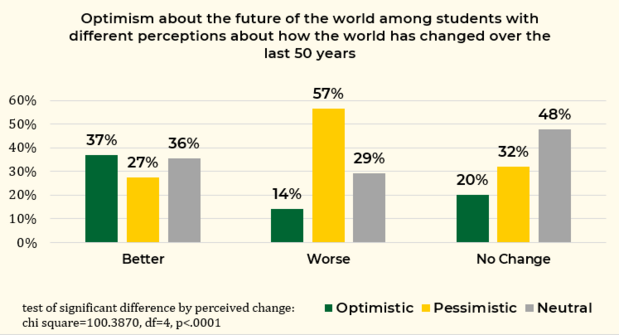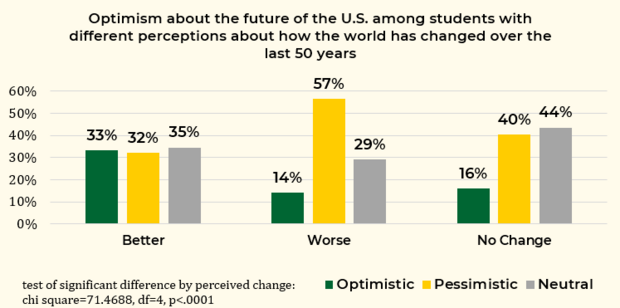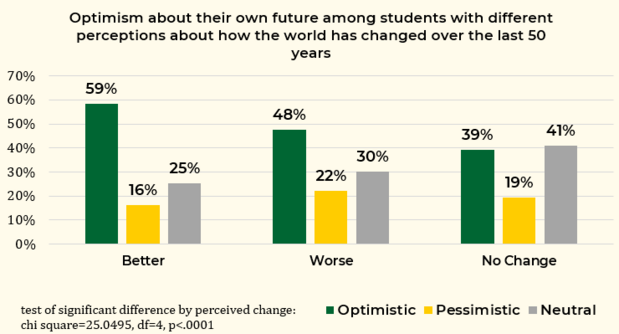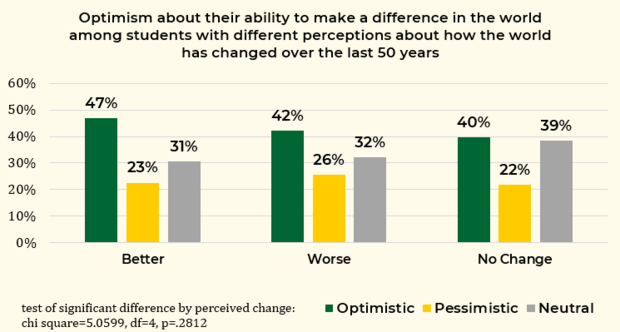Is there a relationship between knowledge of human progress and student optimism?
Introduction
The Sheila and Robert Challey Institute for Global Innovation and Growth, in collaboration with College Pulse, recently conducted the 2021 American College Student Freedom, Progress, and Flourishing Survey. The survey of 1,000 students from 71 four-year colleges and universities assessed student perceptions of viewpoint diversity and campus freedom; human progress and beliefs about the future; and student attitudes toward entrepreneurship, capitalism and socialism, and how college is influencing their views. This research brief focuses on students’ knowledge of human progress and the role it may play in influencing their optimism about the future of the world, the U.S., their own futures, and their ability to make a difference in the world.
Colleges and universities play a vital role in sustaining human progress. Many of the advances in science, medicine, technology, economics, psychology, and other fields that drive human progress are at least partially the result of university research and partnerships between universities and the business community. Moreover, by providing an avenue for students to obtain human capital, colleges and universities contribute to the development of leaders who will shape the future of human progress. The education of effective leaders entails not only transferring knowledge and critical thinking skills, but helping students develop a mindset that spurs them to take actions to further human progress.
Optimism and human progress.Previous research in psychology suggests that optimism likely plays an important role in facilitating human progress. Geers, et. al (2009) find that individuals are more engaged and more likely to achieve goals that are high priority to them when they are optimistic.[1] Solberg Nes et. al (2009) find that optimistic college students get higher grades and are far less likely to drop out of college than pessimistic students.[2] Jimenez, et. al (2021) find that groups comprised of optimistic individuals perform better in terms of achieving tasks, creativity, and teamwork.[3] Uslaner (1998) reports that higher levels of optimism predict higher levels of social trust, which in turn predict greater civic engagement.[4] Assad et. al (2007) find that optimism is positively linked to cooperative problem-solving.[5] And Li and Wu (2011) report that optimism positively predicts innovative behavior.[6]
These and related findings identify optimism as an important psychological resource for the continuation of human progress. Since optimism likely plays a role in motivating individuals to take actions that can sustain human progress, colleges and universities should strive to produce optimism in their students. However, little attention has been given to the actions universities and colleges can take to foster optimism among students. We propose that providing students with an accurate understanding of human progress may lead to increased optimism.
Past research on the promotion of optimism has largely focused on using cognitive-behavioral therapy tools in order to help people manage stress and prevent depression. For instance, Seligman et. al (2007) found that cognitive-behavioral training sessions that involved teaching students at risk of depression how to replace negative thoughts and irrational beliefs with more constructive interpretations increased optimism and well-being.[7] One way to more broadly increase optimism among students might be to educate them about human progress. Students who understand the history of progress in terms of reductions in extreme poverty, increases in life expectancy, decreases in violence, and increases in equality will have fact-based information to develop the types of positive cognitions needed to feel optimistic about the future.
Survey Results
Measuring knowledge of human progress. In order to assess student knowledge of human progress, we asked students whether the world has been getting better or worse over the last 50 years. We asked them to consider objective measures such as extreme poverty, life expectancy, hunger, and literacy. Since our focus was on examining how colleges and universities influence student views, we instructed participants to base their responses on what they have learned in college so far. Specifically, we asked students the following question:
Based on what you have learned in college so far, do you think that the world has generally been getting better or worse over the last 50 years? (considering issues such as extreme poverty, life expectancy, hunger, and literacy)
We used these specific examples because they have all improved dramatically over the indicated timeframe: extreme poverty dropped from 43 percent of the world’s population in 1981 to around 9 percent today;[8] global life expectancy increased from 57.9 years in 1972 to about 72 years today;[9] the percent of undernourished people living in developing countries declined from 23 percent in 1990 to about 13 percent today;[10] and the percentage of 15- to 24 year-olds worldwide who are unable to read dropped from 24 percent to less than 10 percent over a 50 year period.[11]
In answering this question, only 49 percent of students responding to the survey said the world has gotten better over the last 50 years, while 35 percent said it has gotten worse, and another 16 percent said it has not changed.
Measuring optimism. We measured student optimism in several areas, including optimism about the future of the world, optimism about the future of the U.S., optimism about their own futures, and optimism about their ability to make a difference in the world. Again, we instructed participants to base their responses on what they have learned in college so far.
The results show that only 26 percent of students are optimistic about the future of the world, while 39 percent are pessimistic, and 35 percent have a neutral view about the future of the world. Similarly, when asked about the future of the U.S., 24 percent of students are optimistic, 42 percent are pessimistic, and 34 percent have a neutral view.
Results show higher optimism regarding students’ views of their own futures and their ability to make a difference in the world, but large numbers of students remain unoptimistic. Fifty-two percent of students participating in the survey report being optimistic about their own future, while 18 percent are pessimistic, and 30 percent are neutral about their own future. When it comes to their ability to make a difference in the world, 44 percent are optimistic, 23 percent are pessimistic, and 33 percent have a neutral view.
The remainder of this research brief explores the relationship between students’ knowledge of human progress over the last 50 years and their degree of optimism.
Statistical Tests
Figure 1 shows the relationship between student optimism about the future of the world and knowledge of human progress. As the figure shows, 37 percent of students who think the world has gotten better over the last 50 years are optimistic about the future of the world, compared to 14 percent of students who think the world has gotten worse and 20 percent of students who think the world has not changed.
While this suggests that being educated about human progress may lead to increased optimism about the world, the variable that measures knowledge of human progress may be capturing other things that influence optimism, such as political views, socioeconomic status, general well-being, and the extent to which professors are directly encouraging optimism.
In order to test for this, we regress optimism about the future of the world on the following variables: (1) knowledge of human progress (World-Change); (2) self-identified political affiliation (Political); (3) self-identified socioeconomic status (Socioeconomic Status); (4) VanderWeele’s (2017) Flourishing Index (Human Flourishing Index);[12] (5) perceived ability to find and maintain a sense of meaning or purpose in life (Existential Agency); (6) how often students perceive their professors as inspiring them to feel optimistic about the future of the world (Professors Inspire); and (7) sex (Female=1).
We find that knowledge of human progress has a statistically significant and positive relationship with optimism about the future of the world, even after controlling for these other influences (see Table 1). Although this does not show the direction of causality – optimism could lead to perceptions that the world has gotten better – it is suggestive of an important role played by knowledge of progress in fueling optimism about the world.
Figure 1: How does optimism about the future of the world vary with different individual characteristics of college students?
Table 1: Estimation Results – Optimism About the Future of the World
Variable | Parameter Estimate |
Intercept | -0.0141 |
World Change (3 = better, 2 = no change, 1 = worse) | 0.2402* |
Political (1 = liberal, 6 = conservative) | 0.0051 |
Socioeconomic Status (1 = upper class, 5 = lower class) | 0.0120 |
Human Flourishing Index (1 = low, 10 = high) | 0.0757* |
Existential Agency (1 = low, 7 = high) | 0.0462 |
Professors Inspire Optimism About the World | 0.1587* |
Female | 0.0447 |
# 3=optimistic, 2=neutral, 1=pessimistic |
Just as students with more knowledge of progress over the last 50 years are more optimistic about the future of the world, they are also more optimistic about the future of the U.S. Figure 2 shows 33 percent of students who think the world has gotten better over the last 50 years are optimistic about the future of the U.S., compared to 14 percent of students who think the world has gotten worse and 16 percent of students who think the world has not changed.
Table 2 shows that knowledge of progress has a statistically significant impact on optimism about the future of the U.S after controlling for political ideology, socioeconomic status, flourishing, existential agency, frequency of professors inspiring them to feel optimistic about the future of the U.S., and sex. As with the regression in Table 1, this relationship is correlational. Nonetheless, it suggests an important role for teaching students about human progress.
Figure 2: How does optimism about the future of the U.S. vary with different individual characteristics of college students?
Table 2: Estimation Results – Optimism About the Future of the U.S.
Variable | Parameter Estimate |
Intercept | 0.0340 |
World Change (3 = better, 2 = no change, 1 = worse) | 0.2345* |
Political (1 = liberal, 6 = conservative) | 0.0184 |
Socioeconomic Status (1 = upper class, 5 = lower class) | 0.0109 |
Human Flourishing Index (1 = low, 10 = high) | 0.0470*** |
Existential Agency (1 = low, 7 = high) | 0.0512 |
Professors Inspire Optimism About the U.S. | 0.1735* |
Female | 0.0478 |
# 3=optimistic, 2=neutral, 1=pessimistic |
Figure 3 highlights the relationship between knowledge of human progress and students’ optimism about their own futures. As the figure shows, students who have an accurate view of human progress are more likely to be optimistic about their own future. Fifty-nine percent of students who believe the world has gotten better over the last 50 years are optimistic about their own future, compared to 48 percent of students who think the world has gotten worse and 39 percent of students who believe the world has not changed.
Table 3 shows a regression measuring the relationship between knowledge of human progress and students’ optimism about their own future, after controlling for other influences. As the table shows, knowledge of human progress has a statistically significant positive influence on students’ optimism about their own futures. This result, while not showing causality, provides additional evidence for the potentially broad role educating students about human progress could have on optimism. Not only does knowledge of human progress seem to fuel optimism regarding the state of the world or the nation, it also impacts students’ beliefs about their individual futures.
Figure 3: How does optimism about students’ own futures vary with different individual characteristics of college students?
Table 3: Estimation Results – Optimism About Students’ Own Futures
Variable | Parameter Estimate |
Intercept | 0.6963* |
World Change (3 = better, 2 = no change, 1 = worse) | 0.0871* |
Political (1 = liberal, 6 = conservative) | -0.0009 |
Socioeconomic Status (1 = upper class, 5 = lower class) | 0.0157 |
Human Flourishing Index (1 = low, 10 = high) | 0.0794* |
Existential Agency (1 = low, 7 = high) | 0.1817* |
Female | 0.0021 |
# 3=optimistic, 2=neutral, 1=pessimistic |
Figure 4 shows the relationship between students’ knowledge of human progress and optimism about their ability to make a difference in the world. As with other forms of optimism, students who have more knowledge of human progress are more optimistic about their ability to make a difference in the world. However, unlike other forms of optimism, differences among groups are not statistically significant.
Table 4 shows a regression examining the determinants of students’ optimism about their ability to make a difference in the world. As the table shows, knowledge of human progress has a positive and statistically significant (at the 10 percent level) impact on optimism about students’ ability to make a difference in the world, after controlling for other influences.
Figure 4: How does optimism about students’ optimism about their ability to make a difference in the world vary with different individual characteristics of college students?
Table 4: Estimation Results – Optimism About Ability to Make a Difference in the World
Variable | Parameter Estimate |
Intercept | 0.9630* |
World Change (3 = better, 2 = no change, 1 = worse) | 0.0562*** |
Political (1 = liberal, 6 = conservative) | -0.0083 |
Socioeconomic Status (1 = upper class, 5 = lower class) | -0.0669** |
Human Flourishing Index (1 = low, 10 = high) | 0.0528** |
Existential Agency (1 = low, 7 = high) | 0.1759* |
Female | 0.1687* |
# 3=optimistic, 2=neutral, 1=pessimistic |
Conclusion
These results show a strong relationship between knowledge of human progress and optimism among college and university students. Although the results are correlational and we are not able to assess the direction of causality, they are suggestive of an important role for universities in fostering optimism among students.
Universities may be able to help students develop the optimistic mindset needed to continue the trajectory of human progress by providing them with an accurate picture of human progress to date and an accurate state of the world. More research will be needed to assess the causal nature of the relationship between knowledge of human progress and optimism.
References
[1] Geers, A.J., Wellman, J.A., and G.D. Lassiter (2009). Dispositional optimism and engagement: The moderating influence of goal prioritization. Journal of Personality and Social Psychology, 96(4), 913-932.
[2] Solberg Nes, L., Evans, D.R., and S.C. Segerstrom (2009). Optimism and college retention: Mediation by motivation, performance, and adjustment. Journal of Applied Social Psychology, 39(8), 1887-1912.
[3] Jimenez, W.P., Hu, X., Kenneally, C., and F. Wei (2021). Do they see a half-full water cooler? Relationships among group optimism composition, group performance, and cohesion. Journal of Personnel Psychology, 20(2), 75-83.
[4] Uslaner, E.M. (1998). Social capital, television, and the “mean world”: Trust, optimism, and civic participation. Political Psychology, 19(3), 441-467.
[5] Assad, K.K., Donnellan, M.B., and R.D. Conger (2007). Optimism: An enduring resource for romantic relationships. Journal of Personality and Social Psychology, 93(2), 285-297.
[6] Li, C.H., and J.J. Wu (2011). The structural relationships between optimism and innovative behavior: Understanding potential antecedents and mediating effects. Creativity Research Journal, 23(2), 119-128.
[7] Seligman, M.E.P., Schulman, P., and A.M. Tryon (2007). Group prevention of depression and anxiety symptoms. Behaviour Research and Therapy, 45(6), 1111-1126.
[8]https://data.worldbank.org/indicator/SI.POV.DDAY?end=2017&locations=1W&start=1981&view=chart
[9]https://ourworldindata.org/life-expectancy
[10]https://ourworldindata.org/hunger-and-undernourishment
[11]https://www.proliteracy.org/Blogs/Article/138/How-Has-Literacy-Changed-in-50-Years
[12] Vanderweele’s (2017) Human Flourishing Index is aimed at measuring overall wellbeing, and includes questions to assess happiness and life satisfaction, mental and physical health, meaning and purpose, character and virtue, close social relationships, and financial wellbeing.
About the Authors
John Bitzan
Director of the Sheila and Robert Challey Institute for Global Innovation and Growth at North Dakota State University
Author Bio john.bitzan@ndsu.edu
Clay Routledge
Arden and Donna Hetland Distinguished Professor of Business and Faculty Scholar at the Sheila and Robert Challey Institute for Global Innovation and Growth at North Dakota State University
Released November 2021
The Sheila and Robert Challey Institute for Global Innovation and Growth aims to advance understanding in the areas of innovation, trade and institutions to identify policies and solutions for the betterment of society.
The views expressed in this paper are those of the authors and do not necessarily reflect the views of the Sheila and Robert Challey Institute for Global Innovation and Growth or North Dakota State University.






